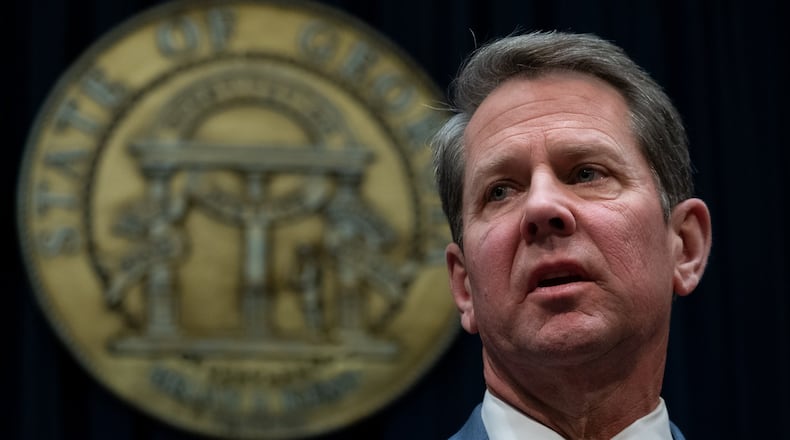Gov. Brian Kemp on Monday banned many gatherings of more than 10 people and ordered “medically fragile” people to shelter in place. He finally ordered bars and nightclubs to shut down. He gave the Department of Public Health authority to close businesses that don’t comply.
But wise public health experts had to worry what he’d done might be too little too late. And he resisted the shelter-in-place orders other states have issued.
He’s finally using his direct authority in trying to stop this COVID-19 pandemic in Georgia.
At his press conference Monday, Kemp, after running down his list of actions, said: “These measures are intended to ensure the health and safety of Georgians across the state.”
But why not act sooner and go further?
It’s hard to compare states directly – and especially hard with Georgia. Our Department of Public Health seems intent on obfuscating and making information difficult for the public to track, and our reporting has shown DPH doesn’t track vital information. It can’t tell citizens, for example, which nursing homes have outbreaks.
But let’s try a state comparison anyway.
Ohio’s governor acted boldly and before others. That state has a population of about 11.7 million. That’s about 1 million more than Georgia.
Early on, Ohio Gov. Mike DeWine banned fans at sporting events – when he had two NCAA tournament sites in his state. (Soon after, the NCAA canceled the tournament.)
Then DeWine closed schools, restaurants and bars. He postponed the presidential primary and on March 10 said Ohio colleges had to stop in-person instruction. Now he’s ordered his citizens to shelter in place.
Meanwhile our governor has meandered, and merely suggested some things that would have had big impact on this pandemic.
On March 12, Kemp suggested schools close. “This is not a mandate,” he said.
He finally did order schools closed, but by then most had closed on their own.
The university system banned in-person classes on its own. Some bars and restaurants closed on their own.
Local communities did the best they could with confused guidance. After 11 cases of the disease were connected to a gathering in Carrollton, city officials held an emergency meeting to block groups of residents from congregating and close restaurants to all but takeout.
“I can’t believe Kemp still won’t act,” said Russell Edwards, an Athens-Clarke County commissioner after he helped engineer a “shelter in place” policy in the governor’s hometown. “How many more people must die before Kemp listens to the experts on how to respond?”
Georgia’s cities and counties became a patchwork of confusing decisions and policies. Despite asking for and receiving emergency powers from the legislature, Kemp has acted slowly.
Requiring local governments to draft and pass their own orders is inefficient. The governor should draft an order that is mandatory in any county with deaths or where local officials adopted it. It’s time to stop leaving communities to draft their own.
Credit Atlanta Mayor Keisha Lance Bottoms for some decisiveness; she closed bars and restaurants in the city. And on Monday, DeKalb County CEO Michael Thurmond issued emergency orders that prohibit dine-in service at restaurants and bars as well as public gatherings of 10 people or more. Other leaders were less wise and clear.
On Monday, Kemp asked Bottoms to wait with her plans to issue a shelter in place order until after his press conference. Why?
Before Kemp acted, at least 37 other states enacted statewide limits on gatherings, and 36 states restricted restaurants and other businesses, according to the National Governors Association. Those restrictions span most Southern states.
And the results of foot-dragging in Georgia? Back to that Ohio comparison.
Georgia has 800 confirmed cases of coronavirus. Ohio has 442. That’s 358 fewer, or about 45 percent fewer.
Twenty-six Georgians have died so far. Ohio has had six deaths, or less than one-fourth as many as Georgia. Of course, there could be many explanations for that difference, but Georgia’s number was 146 cases a week ago. At that point, the state had one death.
If you’d like to know how many patients are hospitalized with COVID-19: Ohio has 104. Georgia? The state has decided not to keep track of that, or at least not to let the public know if in fact the state is tracking that figure.
Many public health leaders consider that the key statistic – the one that will let us know if hospitals are being overwhelmed. You can bet the head of every hospital in Georgia knows that number for their facility.
A governor’s decisions have consequences.
On Monday, Kemp said: “Look out for your fellow Georgians and pray for their continued safety.”
He can do more than that.
The Editorial Board.
About the Author
Keep Reading
The Latest
Featured


